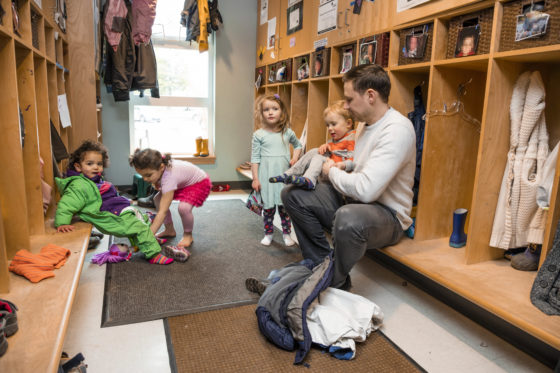Strategically designing the workspace in child care centres helps educators prevent musculoskeletal injuries and provide the best care to kids.

Photo credit: © WorkSafeBC (Workers’ Compensation
Board of B.C.), used with permission
WorkSafeBC ergonomist and human factors specialist Gina Vahlas recently spoke at the 2019 conference of the Early Childhood Educators of BC (ECEBC) about preventing musculoskeletal injuries (MSIs) among those who work in child care.
Child care work involves a lot of reaching, bending, lifting, and other movements that can lead to MSIs. But it doesn’t have to be this way. Gina wants employers and educators to know there are options that will reduce the risk of injuries.
“We’re trying to educate child care employers and workers about how to set up the workspace and use equipment so they can perform at their optimum and deliver high-quality care to kids,” Gina says.
Safety by design also helps optimize performance
During her visits to newly constructed child care centres, Gina saw designs that allowed educators to maintain more upright and neutral body positions while working, reducing MSI risk and improving effectiveness, comfort, and performance.
“The architect who helped design these centres specializes in child care centres and focuses on the functionality of the space,” she says. “He thinks about everyone that interacts with the space and how it can best serve them.”
For example, the cloakrooms have a bench where the educators can sit to help children, reducing the need for them to bend over in an awkward position. Cubbies typically found on the bottom to store shoes were also removed. This meant that when the cleaners came in, they could mop along a flat edge instead of having to move into each cubby, allowing them to clean more effectively and efficiently.
To share these ergonomic solutions with others, Gina worked with the architect, ECEBC, UBC Childcare Services, and a UBC ergonomist to develop a series of 10 WorkSafeBC information sheets. These resources describe ways child care employers and educators can reduce the risk of MSIs during different tasks, such as changing diapers, assisting in the cloakroom, and working in eating areas. Employers and educators can use these sheets for quick safety discussions or when planning changes to the workplace.
Using a systems approach to prevent injury
As an ergonomist, Gina takes a systems approach to addressing the causes behind workplace injuries. She observes the workplace as a whole to see how workers fit — both organizationally and physically — in relation to their tasks, equipment, and work environments.
“Ergonomists look at what kinds of risk controls will make it easier and more comfortable for people to do their jobs,” says Gina. “We make the jobs fit the workers better, so they can be successful in performing them.”
For more information on how to prevent MSIs, see WorkSafeBC’s webpage on Ergonomics.


